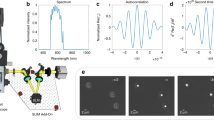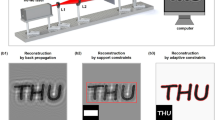Abstract
Holography is a powerful tool to record waves without loss of information that has benefited optical, X-ray and electronic imaging applications by quantifying phase delays induced by light–matter interactions. However, holographic imaging is technically demanding in that it generally requires an interferometric setup, a coherent source and long-term stability. Here, we present holographic imaging in which a phase image is obtained directly from a single intensity measurement in oblique illumination. Our approach is based on space-domain Kramers–Kronig relations that transform the spatial variation in intensity to the spatial variation in phase. We demonstrate two-dimensional holographic imaging and three-dimensional refractive index tomography of microscopic objects and biological specimens from intensity images measured with an optical microscope and illumination control. The proposed method does not require iterative processes nor strict constraints and opens up a new approach to non-interferometric holographic imaging in various spectral regimes.
This is a preview of subscription content, access via your institution
Access options
Access Nature and 54 other Nature Portfolio journals
Get Nature+, our best-value online-access subscription
$29.99 / 30 days
cancel any time
Subscribe to this journal
Receive 12 print issues and online access
$209.00 per year
only $17.42 per issue
Buy this article
- Purchase on Springer Link
- Instant access to full article PDF
Prices may be subject to local taxes which are calculated during checkout





Similar content being viewed by others
Data availability
The data that support the findings of this study are available from the corresponding author upon reasonable request.
Change history
12 July 2021
A Correction to this paper has been published: https://doi.org/10.1038/s41566-021-00856-1
References
Gabor, D. A new microscopic principle. Nature 161, 777–778 (1948).
Yetisen, A. K., Naydenova, I., Vasconcellos, F. D., Blyth, J. & Lower, C. R. Holographic sensors: three-dimensional analyte-sensitive nanostructures and their applications. Chem. Rev. 114, 10654–10696 (2014).
Matoba, O., Nomura, T., Perez-Cabre, E., Millan, M. S. & Javidi, B. Optical techniques for information security. Proc. IEEE 97, 1128–1148 (2009).
Coufal, H. J, Psaltis, D. & Sincerbox, G. T. Holographic Data Storage (Springer, 2000).
Cui, M. & Yang, C. Implementation of a digital optical phase conjugation system and its application to study the robustness of turbidity suppression by phase conjugation. Opt. Express 18, 3444–3455 (2010).
Park, J. H., Park, J., Lee, K. & Park, Y. Disordered optics: exploiting multiple light scattering and wavefront shaping for nonconventional optical elements. Adv. Mater. 32, 1903457 (2019).
Mosk, A. P., Lagendijk, A., Lerosey, G. & Fink, M. Controlling waves in space and time for imaging and focusing in complex media. Nat. Photonics 6, 283–292 (2012).
Yaraş, F., Kang, H. & Onural, L. State of the art in holographic displays: a survey. J. Disp. Technol. 6, 443–454 (2010).
Yu, H., Lee, K., Park, J. & Park, Y. Ultrahigh-definition dynamic 3D holographic display by active control of volume speckle fields. Nat. Photonics 11, 186–192 (2017).
Schnars, U., Falldorf, C., Watson, J. & Jüptner, W. Digital Holography and Wavefront Sensing (Springer-Verlag, 2016). .
Park, Y., Depeursinge, C. & Popescu, G. Quantitative phase imaging in biomedicine. Nat. Photonics 12, 578–589 (2018).
Momose, A. Recent advances in X-ray phase imaging. Jpn J. Appl. Phys. 44, 6355–6367 (2005).
Kemper, B. & von Bally, G. Digital holographic microscopy for live cell applications and technical inspection. Appl. Opt. 47, A52–A61 (2008).
Midgley, P. A. & Dunin-Borkowski, R. E. Electron tomography and holography in materials science. Nat. Mater. 8, 271–280 (2009).
Eisebitt, S. et al. Lensless imaging of magnetic nanostructures by X-ray spectro-holography. Nature 432, 885–888 (2004).
Tegze, M. & Faigel, G. X-ray holography with atomic resolution. Nature 380, 49–51 (1996).
Teague, M. R. Deterministic phase retrieval: a Green’s function solution. J. Opt. Soc. Am. 73, 1434–1441 (1983).
Waller, L., Tian, L. & Barbastathis, G. Transport of intensity phase-amplitude imaging with higher order intensity derivatives. Opt. Express 18, 12552–12561 (2010).
Rodenburg, J. M. & Faulkner, H. M. L. A phase retrieval algorithm for shifting illumination. Appl. Phys. Lett. 85, 4795–4797 (2004).
Mehta, S. B. & Sheppard, C. J. Quantitative phase-gradient imaging at high resolution with asymmetric illumination-based differential phase contrast. Opt. Lett. 34, 1924–1926 (2009).
Zheng, G., Horstmeyer, R. & Yang, C. Wide-field, high-resolution Fourier ptychographic microscopy. Nat. Photonics 7, 739–745 (2013).
Tian, L. & Waller, L. Quantitative differential phase contrast imaging in an LED array microscope. Opt. Express 23, 11394–11403 (2015).
Zhang, F. C., Pedrini, G. & Osten, W. Phase retrieval of arbitrary complex-valued fields through aperture-plane modulation. Phys. Rev. A 75, 043805 (2007).
Bon, P., Maucort, G., Wattellier, B. & Monneret, S. Quadriwave lateral shearing interferometry for quantitative phase microscopy of living cells. Opt. Express 17, 13080–13094 (2009).
Zhang, F. C. & Rodenburg, J. M. Phase retrieval based on wave-front relay and modulation. Phys. Rev. B 82, 121104 (2010).
Horisaki, R., Ogura, Y., Aino, M. & Tanida, J. Single-shot phase imaging with a coded aperture. Opt. Lett. 39, 6466–6469 (2014).
Lee, K. & Park, Y. Exploiting the speckle-correlation scattering matrix for a compact reference-free holographic image sensor. Nat. Commun. 7, 13359 (2016).
Baek, Y., Lee, K. & Park, Y. High-resolution holographic microscopy exploiting speckle-correlation scattering matrix. Phys. Rev. Appl. 10, 024053 (2018).
Kronig, R. D. L. On the theory of dispersion of X-rays. J. Opt. Soc. Am. 12, 547–557 (1926).
Kramers, H. A. La diffusion de la lumière par les atomes. Atti Cong. Intern. Fis. 2, 545–557 (1927).
Baek, Y., Lee, K., Shin, S. & Park, Y. Kramers–Kronig holographic imaging for high-space-bandwidth product. Optica 6, 45–51 (2019).
Hoenders, B. On the solution of the phase retrieval problem. J. Math. Phys. 16, 1719–1725 (1975).
Misell, D. & Greenaway, A. An application of the Hilbert transform in electron microscopy: II. Non-iterative solution in bright-field microscopy and the dark-field problem. J. Phys. D Appl. Phys. 7, 1660 (1974).
Toll, J. S. Causality and the dispersion relation: logical foundations. Phys. Rev. 104, 1760 (1956).
Alexandrov, S. A., Hillman, T. R., Gutzler, T. & Sampson, D. D. Synthetic aperture fourier holographic optical microscopy. Phys. Rev. Lett. 97, 168102 (2006).
Gao, P., Pedrini, G. & Osten, W. Structured illumination for resolution enhancement and autofocusing in digital holographic microscopy. Opt. Lett. 38, 1328–1330 (2013).
Shin, S., Kim, K., Lee, K., Lee, S. & Park, Y. Effects of spatiotemporal coherence on interferometric microscopy. Opt. Express 25, 8085–8097 (2017).
Wolf, E. Three-dimensional structure determination of semi-transparent objects from holographic data. Opt. Commun. 1, 153–156 (1969).
Born, M. & Wolf, E. Principles of Optics: Electromagnetic Theory of Propagation, Interference and Diffraction of Light (Cambridge Univ. Press, 1999). .
Sun, J., Chen, Q., Zhang, J., Fan, Y. & Zuo, C. Single-shot quantitative phase microscopy based on color-multiplexed Fourier ptychography. Opt. Lett. 43, 3365–3368 (2018).
Kim, K., Kim, K. S., Park, H., Ye, J. C. & Park, Y. Real-time visualization of 3-D dynamic microscopic objects using optical diffraction tomography. Opt. Express 21, 32269–32278 (2013).
Ling, R., Tahir, W., Lin, H. Y., Lee, H. & Tian, L. High-throughput intensity diffraction tomography with a computational microscope. Biomed. Opt. Express 9, 2130–2141 (2018).
Matlock, A. & Tian, L. High-throughput, volumetric quantitative phase imaging with multiplexed intensity diffraction tomography. Biomed. Opt. Express 10, 6432–6448 (2019).
Chen, B. & Stamnes, J. J. Validity of diffraction tomography based on the first Born and the first Rytov approximations. Appl. Opt. 37, 2996–3006 (1998).
Lim, J. et al. Comparative study of iterative reconstruction algorithms for missing cone problems in optical diffraction tomography. Opt. Express 23, 16933–16948 (2015).
Lee, M., Shin, S. & Park, Y. Reconstructions of refractive index tomograms via a discrete algebraic reconstruction technique. Opt. Express 25, 27415–27430 (2017).
Sung, Y. & Dasari, R. R. Deterministic regularization of three-dimensional optical diffraction tomography. J. Opt. Soc. Am. A 28, 1554–1561 (2011).
Tian, L. & Waller, L. 3D intensity and phase imaging from light field measurements in an LED array microscope. Optica 2, 104–111 (2015).
Kamilov, U. S. et al. Learning approach to optical tomography. Optica 2, 517–522 (2015).
Chowdhury, S. et al. High-resolution 3D refractive index microscopy of multiple-scattering samples from intensity images. Optica 6, 1211–1219 (2019).
Lim, J., Ayoub, A. B., Antoine, E. E. & Psaltis, D. High-fidelity optical diffraction tomography of multiple scattering samples. Light Sci. Appl. 8, 82 (2019).
Fan, S., Smith-Dryden, S., Li, G. & Saleh, B. Reconstructing complex refractive-index of multiply-scattering media by use of iterative optical diffraction tomography. Opt. Express 28, 6846–6858 (2020).
Zhou, K. C. & Horstmeyer, R. Diffraction tomography with a deep image prior. Opt. Express 28, 12872–12896 (2020).
Tian, L. et al. Computational illumination for high-speed in vitro Fourier ptychographic microscopy. Optica 2, 904–911 (2015).
Lanni, F. & Baxter, G. J. Sampling theorem for square-pixel image data. In Proc SPIE 1660, Biomedical Image Processing and Three-Dimensional Microscopy 140–147 (1992).
Acknowledgements
This work is supported by KAIST Up programme, the BK21+ programme, Tomocube, Inc. and the National Research Foundation of Korea (2017M3C1A3013923, 2015R1A3A2066550, 2018K000396).
Author information
Authors and Affiliations
Contributions
Y.B. and Y.P. conceived the project. Y.B. developed the mathematical framework and conducted the experiment. Y.B. and Y.P. wrote the manuscript. Y.P. provided supervision.
Corresponding author
Ethics declarations
Competing interests
Y.P. has financial interests in Tomocube, Inc., a company that commercializes optical diffraction tomography and quantitative phase imaging instruments and is one of the sponsors of the work.
Additional information
Peer review information Nature Photonics thanks the anonymous reviewers for their contribution to the peer review of this work.
Publisher’s note Springer Nature remains neutral with regard to jurisdictional claims in published maps and institutional affiliations.
Supplementary information
Supplementary Information
Supplementary Figs. 1–6 and discussion.
Supplementary Video 1
Time-lapse maximum intensity projection images of the RI tomogram of an A549 cell.
Rights and permissions
About this article
Cite this article
Baek, Y., Park, Y. Intensity-based holographic imaging via space-domain Kramers–Kronig relations. Nat. Photonics 15, 354–360 (2021). https://doi.org/10.1038/s41566-021-00760-8
Received:
Accepted:
Published:
Issue Date:
DOI: https://doi.org/10.1038/s41566-021-00760-8
This article is cited by
-
Randomness assisted in-line holography with deep learning
Scientific Reports (2023)
-
Artificial intelligence-enabled quantitative phase imaging methods for life sciences
Nature Methods (2023)
-
Non-interferometric stand-alone single-shot holographic camera using reciprocal diffractive imaging
Nature Communications (2023)
-
In-silico clearing approach for deep refractive index tomography by partial reconstruction and wave-backpropagation
Light: Science & Applications (2023)
-
Adaptive optical quantitative phase imaging based on annular illumination Fourier ptychographic microscopy
PhotoniX (2022)



